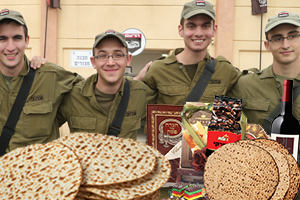A 3,000 year old Jewish Temple and sacred vessels dated from the reign of King David have been discovered in Tel Motza, right outside Jerusalem. According to Anna Eirikh, Dr. Hamoudi Khalaily and Shua Kisilevitz, who are in charge of the excavation on behalf of the Israel Antiquities Authority, “The ritual building at Tel Motza is an unusual and striking find, in light of the fact that there are hardly any remains of ritual buildings of the period in Judaea at the time of the First Temple. The uniqueness of the structure is even more remarkable because of the vicinity of the site’s proximity to the capital city of Jerusalem, which acted as the Kingdom’s main sacred center at the time.”
At around the time of Hezekiah and Jeremiah, Judaism abolished many ritual sites outside the Holy City in order to concentrate religious power at the Jewish Temple in Jerusalem. For this reason, a find such as this one is a rare gem! Tel Motza and the surrounding area are well-known for their archaeological richness. Many archaeological discoveries from a variety of periods have been unearthed in that area, among them a public building, a large structure with storehouses and a site utilized to store Jerusalem’s grain supplies.
Archaeological experts have proposed identifying the Tel Motza archaeological site with the Biblical settlement of Motza that is mentioned in Joshua 18:26 as a town in the tribal lands of Binyamin. When the Jewish Temple existed, Jews would gather willow branches from Motza for Sukkot and Hoshana Raba. Throughout Sukkot, Jews would place these willow branches at the side of their alters; they would then sound the shofar, which would be heard once every day of Sukkot and seven times on Hoshana Raba.
The rituals Jews performed with these willows gathered at Motza is recorded in the Mishna, Sukka 4:2, “They would go down there and pick branches of willows and would then come and place them alongside the altar with the heads (of the willow branches) bent over the altar. They then sounded the shofar. […] Each day they would circle the altar once and say, “Please, G-d, bring us salvation… Please, G-d, bring us success…” On that day (i.e., Hoshana Raba), they circled the altar seven times. When they had finished they would say, “Beauty is yours, O altar.’”
An Israel Antiquities Authority statement described the walls of the Jewish Temple structure found at Tel Motza as massive and claimed that it confirmed to the tradition of temple construction in the ancient Middle East. A square structure which experts believe to be an altar was found in the temple courtyard and the collection of sacred vessels was found nearby. These sacred vessels include figurines of men and horses, as well pottery fragments and ritual bowls and pedestals. The archaeologists emphasize that “the find of the sacred structure together with the accompanying cache of sacred vessels, and especially the significant coastal influence evident in the anthropomorphic figurines, still require extensive research.”
By Rachel Avraham
Send Passover Packages to Needy Israeli Soldiers - Bring Them Joy!
We are honored to thank the young men and women of the IDF who risk their lives every day to protect the citizens of Israel. Since October 7th, soldiers have been on the battlefield for months - many are hoping to come home for Passover.
Join us in sending Passover food packages (and personal notes) to Israeli soldiers and their families.
Many soldiers spend the Passover holiday with needy families back home. The soldiers greatly appreciate your love and concern. Bring them Passover joy!
CLICK HERE TO SEND YOUR PACKAGE AND NOTE TO ISRAELI SOLDIERS!



